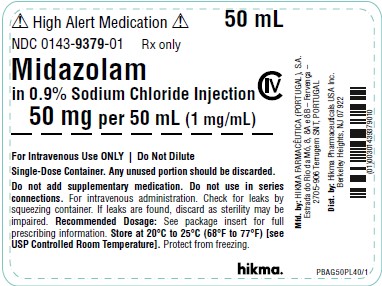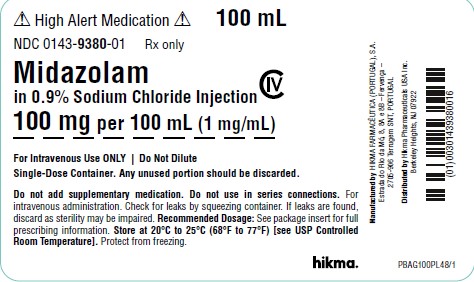These highlights do not include all the information needed to use MIDAZOLAM IN SODIUM CHLORIDE INJECTION safely and effectively. See full prescribing information for MIDAZOLAM IN SODIUM CHLORIDE INJECTION. MIDAZOLAM IN SODIUM CHLORIDE injection, for intravenous use, CIV Initial U.S. Approval: 1985
Midazolam in Sodium Chloride by
Drug Labeling and Warnings
Midazolam in Sodium Chloride by is a Prescription medication manufactured, distributed, or labeled by Hikma Farmaceutica, Hikma Pharmaceuticals USA Inc.. Drug facts, warnings, and ingredients follow.
Drug Details [pdf]
MIDAZOLAM IN SODIUM CHLORIDE- midazolam in sodium chloride injection
Hikma Farmaceutica
----------
HIGHLIGHTS OF PRESCRIBING INFORMATION
These highlights do not include all the information needed to use MIDAZOLAM IN SODIUM CHLORIDE INJECTION safely and effectively. See full prescribing information for MIDAZOLAM IN SODIUM CHLORIDE INJECTION.
MIDAZOLAM IN SODIUM CHLORIDE injection, for intravenous use, CIV Initial U.S. Approval: 1985 ADVERSE REACTIONSThe most common adverse reactions (≥15%) were decreased tidal volume, decreased respiratory rate, and apnea. (6) To report SUSPECTED ADVERSE REACTIONS, contact Hikma Pharmaceuticals USA Inc. at 1-877-845-0689 or FDA at 1-800-FDA-1088 or www.fda.gov/medwatch. Revised: 5/2023 |
FULL PRESCRIBING INFORMATION: CONTENTS*6 ADVERSE REACTIONS |
FULL PRESCRIBING INFORMATION
6 ADVERSE REACTIONS
The following serious adverse reactions are discussed in greater detail in other sections:
- Cardiorespiratory Adverse Reactions [see Warnings and Precautions (5.3)]
- Paradoxical Behavior [see Warnings and Precautions (5.4)]
- Dependence and Withdrawal [see Warnings and Precautions (5.5)]
- Impaired Cognitive Function [see Warnings and Precautions (5.8)]
- Hypotension and Seizure in Preterm Infants and Neonates [see Warnings and Precautions (5.9)]
- Neonatal Sedation and Withdrawal Syndrome [see Warnings and Precautions (5.10), Use in Specific Populations (8.1)]
- Pediatric Neurotoxicity [see Warnings and Precautions (5.11)]
The following adverse reactions have been identified from literature or postmarketing reports of midazolam. Because some of these reactions are reported voluntarily from a population of uncertain size, it is not always possible to reliably estimate their frequency or establish a causal relationship to drug exposure.
Fluctuations in vital signs were the most frequently seen findings following parenteral administration of midazolam in adults and included decreased tidal volume and/or respiratory rate decrease (23.3% of patients following intravenous administration) and apnea (15.4% of patients following intravenous administration), as well as variations in blood pressure and pulse rate. The majority of serious adverse reactions, particularly those associated with oxygenation and ventilation, have been reported when midazolam is administered with other medications capable of depressing the central nervous system. The incidence of such events is higher in patients undergoing procedures involving the airway without the protective effect of an endotracheal tube, (e.g., upper endoscopy and dental procedures).
Adults
Table 2: Additional Adverse Reactions Reported Subsequent to Intravenous Administration as a Single Sedative/anxiolytic/amnestic Agent in Adult Patients:
hiccoughs (3.9%) Local effects at the intravenous site
nausea (2.8%) tenderness (5.6%)
vomiting (2.6%) pain during injection (5%)
coughing (1.3%) redness (2.6%)
"oversedation" (1.6%) induration (1.7%)
headache (1.5%) phlebitis (0.4%)
drowsiness (1.2%)
Pediatric Patients
The following adverse events related to the use of intravenous midazolam in pediatric patients were reported in the medical literature: desaturation 4.6%, apnea 2.8%, hypotension 2.7%, paradoxical reactions 2%, hiccough 1.2%, seizure-like activity 1.1% and nystagmus 1.1%. The majority of airway-related events occurred in patients receiving other CNS depressing medications and in patients where midazolam was not used as a single sedating agent.
Neonates
There have been reports of hypotensive episodes and seizures following the administration of midazolam to neonates, [see Warnings and Precautions (5.9)].
Other Adverse Reactions Occurring at an Incidence of <1% Following Intravenous Injection as a Single Sedative/Anxiolytic/Amnesia Agent
Respiratory: Laryngospasm, bronchospasm, dyspnea, hyperventilation, wheezing, shallow respirations, airway obstruction, tachypnea
Cardiovascular: Bigeminy, premature ventricular contractions, vasovagal episode, bradycardia, tachycardia, nodal rhythm
Gastrointestinal: Acid taste, excessive salivation, retching
CNS/Neuromuscular: Retrograde amnesia, euphoria, hallucination, confusion, argumentativeness, nervousness, anxiety, grogginess, restlessness, emergence delirium or agitation, prolonged emergence from anesthesia, dreaming during emergence, sleep disturbance, insomnia, nightmares, athetoid movements, seizure-like activity, ataxia, dizziness, dysphoria, slurred speech, dysphonia, paresthesia
Special Senses: Blurred vision, diplopia, nystagmus, pinpoint pupils, cyclic movements of eyelids, visual disturbance, difficulty focusing eyes, ears blocked, loss of balance, light-headedness
Integumentary: Hive-like elevation at injection site, swelling or feeling of burning, warmth or coldness at injection site
Hypersensitivity: Allergic reactions including anaphylactic reactions, hives, rash, pruritus
Miscellaneous: Yawning, lethargy, chills, weakness, toothache, faint feeling, hematoma
| MIDAZOLAM IN SODIUM CHLORIDE
midazolam in sodium chloride injection |
|||||||||||||||||||||||||
|
|||||||||||||||||||||||||
|
|||||||||||||||||||||||||
|
|||||||||||||||||||||||||
|
|||||||||||||||||||||||||
|
|||||||||||||||||||||||||
| MIDAZOLAM IN SODIUM CHLORIDE
midazolam in sodium chloride injection |
|||||||||||||||||||||||||
|
|||||||||||||||||||||||||
|
|||||||||||||||||||||||||
|
|||||||||||||||||||||||||
|
|||||||||||||||||||||||||
|
|||||||||||||||||||||||||
| Labeler - Hikma Farmaceutica (452742943) |
| Registrant - Hikma Pharmaceuticals USA Inc. (001230762) |
© 2026 FDA.report
This site is not affiliated with or endorsed by the FDA.

